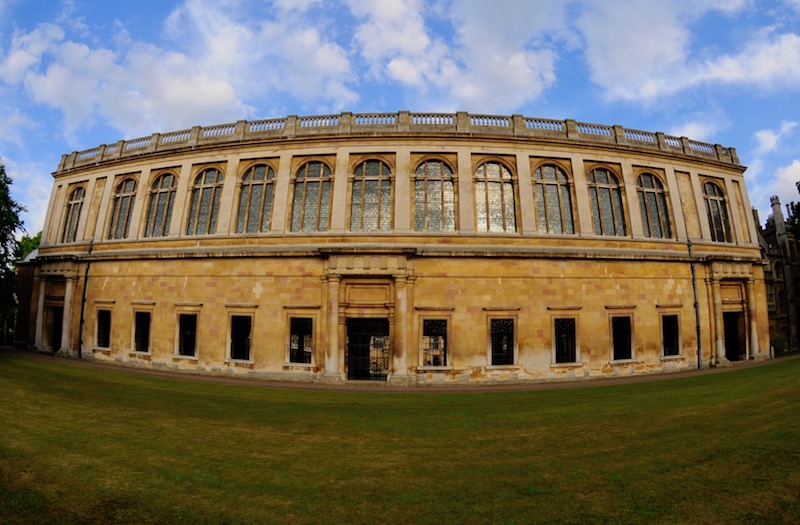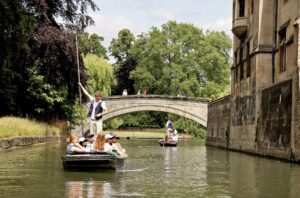The Wren Library: A Must-See Stop Along the River Cam
A quintessential part of the city’s adored riverside, the Wren Library is a breathtaking piece of architecture that is as beautiful as it is historic. Standing tall for nearly 330 years now, the Wren Library is home to some of Trinity College’s most valuable and historic collections. It’s essentially a treasure trove of rare books and manuscripts, with items that shaped literature, science, and history, making it a must-see for any trip to Cambridge.
Historical Background
The Wren Library, an architectural masterpiece, was designed by Sir Christopher Wren for Trinity College. It reached completion in 1695 and was created to both store knowledge and showcase the college’s immense academic pride.
Trinity College is one of Cambridge’s most distinguished and recognised institutions. Throughout the years, it has produced an extraordinary roster of alumni, in which the library’s treasures reflect this heritage.
The Wren Library is home to a wide range of influential works, including notes written by Sir Isaac Newton, who studied at Trinity. On display are also the personal belongings of the poet Lord Byron. Additionally, the collection contains manuscripts written by A.A. Milne.
Architecturally, the Wren Library is a masterpiece of classical design. It blends elegance with practical function. Its high, graceful windows flood the interior with natural light, illuminating the oak bookcases and vaulted ceilings. The library is admired for its symmetry, proportion, and serene atmosphere. Today, it remains not only a working library but also a living monument to centuries of scholarship in Cambridge.
The Library’s Treasures
Stepping inside the Wren Library feels like walking into a time capsule of knowledge. Its collection houses some of the rarest and most remarkable treasures in Cambridge. Among its shelves are Sir Isaac Newton’s own annotated books, filled with the scribbles of the man who redefined science. Visitors are often delighted to learn that the original manuscript of Winnie-the-Pooh also resides here, acting as a charming counterpoint to the weighty scientific works. The library also safeguards beautifully illuminated medieval manuscripts. Each one offers a glimpse into the intellectual and artistic world of centuries past.
Together, these items form more than just a collection; they chart the course of human thought. Ranging from medieval scholarship to children’s favourite literature, and from groundbreaking discoveries to cultural touchstones.
The Wren Library is a reminder of how ideas can endure and evolve across generations. This aspect of the library has been appreciated by both scholars and casual visitors for as long as it’s been standing.
Did you know? The library’s collection includes letters from early alumni that mention punting on the River Cam—proof that this quintessential Cambridge pastime has been enjoyed for centuries!

Visiting the Wren Library
The Wren Library is open to the public, though visiting times vary with the season. Typically, it welcomes visitors in the late mornings and early afternoons, but hours can be shorter in winter and longer in summer. Admission is free, though entry is limited to specific time slots, so it’s worth checking ahead before planning a trip. Visitors should note a few rules: photography is not permitted inside, and bags are not allowed beyond the entrance, helping to preserve the collection for future generations.
Conveniently, the library is situated within Trinity College, right beside the River Cam. This makes it a highlight of our punting route. Guests can enjoy stunning riverside views of the college before stepping inside to explore one of Cambridge’s most remarkable treasures.
For more information on visiting hours, click here!
The Wren Library from the River Cam
One of the most striking views of the Wren Library is from the water. As your punt glides past Trinity College, the library appears in perfect symmetry. Its tall windows catch the light and reflect in the River Cam beautifully. From this angle, you can appreciate the building’s scale and harmony in a way that isn’t possible from inside the college grounds. Punting offers a relaxed, unhurried perspective. Those on foot see the library as a destination, whereas those on the river experience it as part of the timeless Cambridge landscape.
For the full experience, we recommend combining a visit to the library with a punting tour. That way, you can admire its treasures and enjoy the unforgettable riverside view that has inspired generations of visitors.
Fun Facts & Lesser-Known Stories
Pooh in the Library – The original manuscripts of Winnie-the-Pooh and The House at Pooh Corner by A. A. Milne are preserved here. They add a touch of childhood charm among the scholarly tomes.
Built Above the Floods – The Wren Library sits on an open cloister, raising it above ground level. This clever design keeps the collection safe from the River Cam’s damp air and occasional floods.
Windows to the Sky – The grand west-facing windows bathe the library in light, and they don’t frame river views as many expect when looking out; you’ll see sky instead.
Carvings to Admire – Take a closer look at the bookshelves: many of the delicate limewood carvings are by Grinling Gibbons, one of the finest woodcarvers of the 17th century.
The Wren Library is more than just a collection of books—it’s a window into centuries of history, discovery, and imagination. From Newton’s annotated works to Milne’s Winnie-the-Pooh manuscripts, it captures the spirit of Cambridge like few places can. And while stepping inside is unforgettable, the view from the River Cam is equally spectacular. Why not enjoy both? Book a punting tour with us and see the library in its most iconic setting before exploring it up close.







